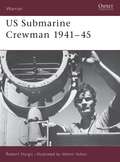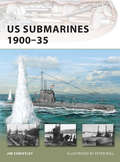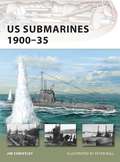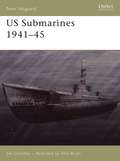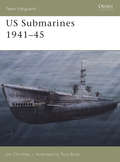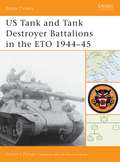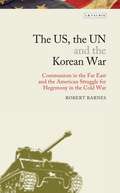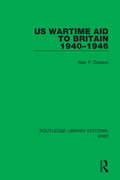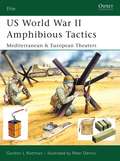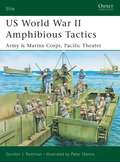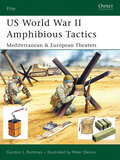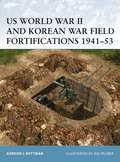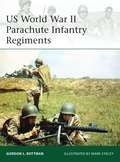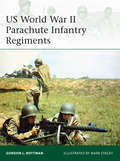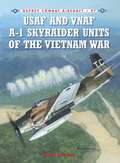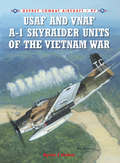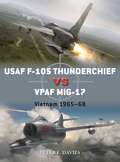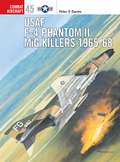- Table View
- List View
US Submarine Crewman 1941–45 (Warrior)
by Velimir Vuksic Robert HargisThis book takes a close look at the "Dolphins" of the US Navy submarine force, it covers recruitment, training, service conditions and combat experiences, and discusses the effects of advances in torpedo technology on crew roles. The Japanese surprise attack on Pearl Harbor in December 1941 battered the surface fleet, but the submarine force escaped unharmed. It was up to the "Silent Service" to spearhead the naval war against Japan, cutting her supply routes and neutralizing her naval threat. By August 1945, US Navy submarines had made 488 war patrols. The achievements of the "Silent Service" were not without consequence 3,500 American crewmen lost their lives.
US Submarines 1900–35 (New Vanguard #175)
by Jim ChristleyThis book introduces the reader to the early years of US submarine development and operation during the first third of the 20th century. It was in this period of growth and change that the submarine moved from a small vessel of limited range and tactical strength to a far ranging force. It also covers the little-told story of the United State's submarine force during World War I, and the lessons they learned that would be passed on to future generations of submariners.
US Submarines 1900–35 (New Vanguard)
by Jim Christley Peter BullThis book introduces the reader to the early years of US submarine development and operation during the first third of the 20th century. It was in this period of growth and change that the submarine moved from a small vessel of limited range and tactical strength to a far ranging force. It also covers the little-told story of the United State's submarine force during World War I, and the lessons they learned that would be passed on to future generations of submariners.
US Submarines 1941–45 (New Vanguard)
by Tony Bryan Jim ChristleyNaval warfare in the Pacific changed completely with the Japanese attack on Pearl Harbor in 1941. The strategic emphasis shifted from battleships to much more lethal, far-ranging weapons systems; one of these was the submarine. This book details the design and development, classes, weapons and equipment, tactics and operational history of the US submarine in World War II. Detailed tables, photographs, and superb color plates depict the force that had an effect far beyond its size – the submarine accounted for 55% of all Japanese shipping losses, despite suffering the highest percentage loss of any unit of the United State Armed Forces in World War II.
US Submarines 1941–45 (New Vanguard #118)
by Tony Bryan Jim ChristleyNaval warfare in the Pacific changed completely with the Japanese attack on Pearl Harbor in 1941. The strategic emphasis shifted from battleships to much more lethal, far-ranging weapons systems; one of these was the submarine. This book details the design and development, classes, weapons and equipment, tactics and operational history of the US submarine in World War II. Detailed tables, photographs, and superb color plates depict the force that had an effect far beyond its size – the submarine accounted for 55% of all Japanese shipping losses, despite suffering the highest percentage loss of any unit of the United State Armed Forces in World War II.
US Tank and Tank Destroyer Battalions in the ETO 1944–45 (Battle Orders)
by Steven J. ZalogaOvershadowed by the United States Army's armored divisions, the separate tank and tank destroyer battalions had the difficult mission of providing armored support for US infantry divisions in the 1944–45 campaigns. This book details the organizational structures and deployment of these units: the standard tank battalions, tank battalions (light), tank battalions (mine exploder) and tank battalions (special), self-propelled and towed tank destroyer battalions. It also covers the tactics used by these units in their attempts to assist the infantry, as well as providing a listing of all the battalions that took part in the Northwest Europe campaign.
US Tank and Tank Destroyer Battalions in the ETO 1944–45 (Battle Orders Ser. #10)
by Steven J. ZalogaOvershadowed by the United States Army's armored divisions, the separate tank and tank destroyer battalions had the difficult mission of providing armored support for US infantry divisions in the 1944–45 campaigns. This book details the organizational structures and deployment of these units: the standard tank battalions, tank battalions (light), tank battalions (mine exploder) and tank battalions (special), self-propelled and towed tank destroyer battalions. It also covers the tactics used by these units in their attempts to assist the infantry, as well as providing a listing of all the battalions that took part in the Northwest Europe campaign.
The US, the UN and the Korean War: Communism in the Far East and the American Struggle for Hegemony in the Cold War (Library of Modern American History)
by Robert BarnesMilitary, social and economic historians have long appreciated the significance of the conflict in Korea in shaping the post-war world. The policy of containment was formed, China was established as an important military power, and the US increased its military expenditure fourfold as a result of a conflict which killed over 33,000 Americans. What has been less appreciated is the role played by the United Nations and the British Commonwealth in influencing US strategy at this time of crisis: the Truman administration invested time and effort into gaining UN approval for the conflict in Korea, and the course of the war was adapted to keep UN allies, often holding crucial strategic positions in other Cold War theatres, in tow. This groundbreaking study explores these fluctuating relationships, the tensions between Washington and its British Commonwealth allies and their impact on the development of the conflict, from its outbreak in 1950 to its end at the Geneva Conference of 1954. Robert Barnes reframes the Korean War for the first time in the context of a United States less dominant than is usually imagined. This will be essential reading for students of International Relations, Cold War Studies and modern History.
The US War Against ISIS: How America and its Allies Defeated the Caliphate
by Aaron SteinThe war against ISIS is often explained through the group's own rise to power. The American side of the story has not yet been told. This book records how the United States and its allies chose to fight the group, what the consequences have been for transatlantic relations, and how these factors may shape future wars the West decides to pursue.The book is based on first-person interviews with U.S. and European policymakers, and members of the military in direct combat against ISIS - from U.S and allied forces on the ground to the Kurdish fighters who fought beside them. These interviews show precisely how the West fights wars through the eyes of the people most involved in them and includes key insights about civilian decision-making as it happened. In tracing the war as it developed, the book examines the West's approach to conflict and reveals new insights such as why both the U.S. military and the civilian bureaucracy underestimated Russian military capabilities. The war was always meant to be small and focused, but its repercussions have been considerable and far-reaching, including a serious rupture in Turkish-Western relations and Russia's return to the Middle East.Aaron Stein shows why mistakes were made in the war against ISIS and what happens when a narrow policy focus on counter terrorism is pursued at the expense of almost all wider regional security and political concerns. At a time when the U.S might be called again to stem the rise of a terror group or to fight against a collective threat, the lessons in this book are essential.
The US War Against ISIS: How America and its Allies Defeated the Caliphate
by Aaron SteinThe war against ISIS is often explained through the group's own rise to power. The American side of the story has not yet been told. This book records how the United States and its allies chose to fight the group, what the consequences have been for transatlantic relations, and how these factors may shape future wars the West decides to pursue.The book is based on first-person interviews with U.S. and European policymakers, and members of the military in direct combat against ISIS - from U.S and allied forces on the ground to the Kurdish fighters who fought beside them. These interviews show precisely how the West fights wars through the eyes of the people most involved in them and includes key insights about civilian decision-making as it happened. In tracing the war as it developed, the book examines the West's approach to conflict and reveals new insights such as why both the U.S. military and the civilian bureaucracy underestimated Russian military capabilities. The war was always meant to be small and focused, but its repercussions have been considerable and far-reaching, including a serious rupture in Turkish-Western relations and Russia's return to the Middle East.Aaron Stein shows why mistakes were made in the war against ISIS and what happens when a narrow policy focus on counter terrorism is pursued at the expense of almost all wider regional security and political concerns. At a time when the U.S might be called again to stem the rise of a terror group or to fight against a collective threat, the lessons in this book are essential.
US Wartime Aid to Britain 1940–1946 (Routledge Library Editions: WW2 #36)
by Alan P. DobsonThis book, first published in 1986, examines the American economic aid that was a vital factor in enabling Britain’s success in the Second World War. Whilst Lend-Lease did keep the British war effort alive, the agreement was always a source of great friction between the two countries. This book argues that although Lend-Lease solved Britain’s wartime supply problems, the price was the acceptance of a series of burdens that seriously aggravated the country’s long-term economic decline.
US Wartime Aid to Britain 1940–1946 (Routledge Library Editions: WW2 #36)
by Alan P. DobsonThis book, first published in 1986, examines the American economic aid that was a vital factor in enabling Britain’s success in the Second World War. Whilst Lend-Lease did keep the British war effort alive, the agreement was always a source of great friction between the two countries. This book argues that although Lend-Lease solved Britain’s wartime supply problems, the price was the acceptance of a series of burdens that seriously aggravated the country’s long-term economic decline.
US World War II Amphibious Tactics: Mediterranean & European Theaters (Elite)
by Peter Dennis Gordon L. RottmanThe US armed forces pioneered amphibious warfare in the Pacific and by the time of the D-day landings they had perfected the special equipment and tactics necessary for this extraordinarily difficult and risky form of warfare. This fact-packed study details the doctrine, equipment and tactics that evolved between the North African landings of November 1942 and those in the South of France in August 1944, and illustrates many aspects of the physical realities of assault landings through the use of photos, diagrams and color plates.
US World War II Amphibious Tactics: Army & Marine Corps, Pacific Theater (Elite)
by Peter Dennis Gordon L. RottmanThe US armed forces were responsible for many tactical innovations during the years 1941–45, but in no field was US mastery more complete than amphibious warfare. In the vast, almost empty battlefield of the Pacific the US Navy and Marine Corps were obliged to develop every aspect of the amphibious assault landing in painstaking detail, from the design of many new types of vessel, down to the tactics of the rifle platoon hitting the beach, and the logistic system without which they could not have fought their way inland. This fascinating study offers a clear, succinct explanation of every phase of these operations as they evolved during the war years, illustrated with detailed color plates and photographs.
US World War II Amphibious Tactics: Army & Marine Corps, Pacific Theater (Elite #117)
by Peter Dennis Gordon L. RottmanThe US armed forces were responsible for many tactical innovations during the years 1941–45, but in no field was US mastery more complete than amphibious warfare. In the vast, almost empty battlefield of the Pacific the US Navy and Marine Corps were obliged to develop every aspect of the amphibious assault landing in painstaking detail, from the design of many new types of vessel, down to the tactics of the rifle platoon hitting the beach, and the logistic system without which they could not have fought their way inland. This fascinating study offers a clear, succinct explanation of every phase of these operations as they evolved during the war years, illustrated with detailed color plates and photographs.
US World War II Amphibious Tactics: Mediterranean & European Theaters (Elite #144)
by Gordon L. RottmanThe US armed forces pioneered amphibious warfare in the Pacific and by the time of the D-day landings they had perfected the special equipment and tactics necessary for this extraordinarily difficult and risky form of warfare. This fact-packed study details the doctrine, equipment and tactics that evolved between the North African landings of November 1942 and those in the South of France in August 1944, and illustrates many aspects of the physical realities of assault landings through the use of photos, diagrams and color plates.
US World War II and Korean War Field Fortifications 1941–53 (Fortress)
by Gordon L. Rottman Ian PalmerThe US Army and Marine Corps in World War II considered themselves highly mobile, offensive forces. Their mobile-warfare doctrine envisioned field fortifications and obstacles as temporary in nature. As a result, their design was simple and made use of local materials, and they could be constructed comparatively quickly, whilst still providing adequate protection. By the time of the Korean War, only minor changes had been made to field fortification construction and layout, and to small-unit organization, weapons, and tactics. This title addresses field fortifications built by US infantrymen during World War II and in Korea, and covers rifle-platoon positions, trenches, crew-served weapon positions, bunkers, dugouts, shelters, observation posts and anti-tank obstacles.
US World War II Parachute Infantry Regiments (Elite)
by Gordon L. Rottman Mark StaceyThe parachute infantry regiments were among the most highly decorated US Army units of World War II, and between them they saw action right across the world. The elite nature of these units led to them being committed to action not only in the way that had been intended; their quality tempted commanders to keep them in the line longer than their light armament justified, and they were tested to the limit. This engaging study traces the story of each of the 17 regiments, from their creation and training in the USA, through their deployments overseas, to their combat jumps and all their battles. The book is illustrated with wartime photographs, many previously unpublished, and eight full-colour plates detailing the specifics of their uniforms, insignia, and equipment practices, which often differed from unit to unit.
US World War II Parachute Infantry Regiments (Elite #198)
by Gordon L. Rottman Mark StaceyThe parachute infantry regiments were among the most highly decorated US Army units of World War II, and between them they saw action right across the world. The elite nature of these units led to them being committed to action not only in the way that had been intended; their quality tempted commanders to keep them in the line longer than their light armament justified, and they were tested to the limit. This engaging study traces the story of each of the 17 regiments, from their creation and training in the USA, through their deployments overseas, to their combat jumps and all their battles. The book is illustrated with wartime photographs, many previously unpublished, and eight full-colour plates detailing the specifics of their uniforms, insignia, and equipment practices, which often differed from unit to unit.
USAF and VNAF A-1 Skyraider Units of the Vietnam War (Combat Aircraft)
by Jim Laurier Byron E HukeeUSAF Skyraider units were originally tasked to serve as quasi-training units for the fledgling VNAF. Equipped only with the two-seat models of the Skyraider, American pilots were required to have VNAF 'observers' in the aircraft for every mission. Eventually, this arrangement was changed as enough Vietnamese pilots were trained to man their own squadrons, while USAF squadrons were tasked with close support for US ground forces. Eventually, no fewer than four USAF and seven VNAF Skyraider units saw service in Vietnam. Additionally, one A-1 training squadron flew from Hurlburt Field, Florida, throughout the Vietnam War era. In the ten years that this squadron was active, nearly 1000 USAF and 300 VNAF pilots were trained in the Skyraider. While the core mission of all Skyraider squadrons was Close Air Support (CAS), other missions were accomplished at various times. Among these were Search and Rescue (SAR), night interdiction on the Ho Chi Minh trail, helicopter escort and special forces support to name but a few. Each of these missions took full advantage of the Skyraider's ability to deliver a variety of munitions in close proximity to friendly forces while inflicting heavy casualties on enemy forces
USAF and VNAF A-1 Skyraider Units of the Vietnam War (Combat Aircraft #97)
by Jim Laurier Byron E HukeeUSAF Skyraider units were originally tasked to serve as quasi-training units for the fledgling VNAF. Equipped only with the two-seat models of the Skyraider, American pilots were required to have VNAF 'observers' in the aircraft for every mission. Eventually, this arrangement was changed as enough Vietnamese pilots were trained to man their own squadrons, while USAF squadrons were tasked with close support for US ground forces. Eventually, no fewer than four USAF and seven VNAF Skyraider units saw service in Vietnam. Additionally, one A-1 training squadron flew from Hurlburt Field, Florida, throughout the Vietnam War era. In the ten years that this squadron was active, nearly 1000 USAF and 300 VNAF pilots were trained in the Skyraider. While the core mission of all Skyraider squadrons was Close Air Support (CAS), other missions were accomplished at various times. Among these were Search and Rescue (SAR), night interdiction on the Ho Chi Minh trail, helicopter escort and special forces support to name but a few. Each of these missions took full advantage of the Skyraider's ability to deliver a variety of munitions in close proximity to friendly forces while inflicting heavy casualties on enemy forces
USAF F-105 Thunderchief vs VPAF MiG-17: Vietnam 1965–68 (Duel)
by Peter E. DaviesThe F-105D Thunderchief was originally designed as a low-altitude nuclear strike aircraft, but the outbreak of the Vietnam War led to it being used instead as the USAF's primary conventional striker against the exceptionally well-defended targets in North Vietnam and Laos. F-105 crews conducted long-distance missions from bases in Thailand, refuelling in flight several times and carrying heavy external bombloads.The MiG-17 was the lightweight, highly manoeuvrable defending fighter it encountered most often in 1965–68 during Operation Rolling Thunder. A development of the MiG-15, which shocked UN forces during the Korean War, its emphasis was on simplicity and ease of maintenance in potentially primitive conditions.Fully illustrated with stunning artwork, this book shows how these two aircraft, totally different in design and purpose, fought in a series of duels that cost both sides dearly.
USAF F-105 Thunderchief vs VPAF MiG-17: Vietnam 1965–68 (Duel #95)
by Peter E. DaviesThe F-105D Thunderchief was originally designed as a low-altitude nuclear strike aircraft, but the outbreak of the Vietnam War led to it being used instead as the USAF's primary conventional striker against the exceptionally well-defended targets in North Vietnam and Laos. F-105 crews conducted long-distance missions from bases in Thailand, refuelling in flight several times and carrying heavy external bombloads.The MiG-17 was the lightweight, highly manoeuvrable defending fighter it encountered most often in 1965–68 during Operation Rolling Thunder. A development of the MiG-15, which shocked UN forces during the Korean War, its emphasis was on simplicity and ease of maintenance in potentially primitive conditions.Fully illustrated with stunning artwork, this book shows how these two aircraft, totally different in design and purpose, fought in a series of duels that cost both sides dearly.
USAF F-4 Phantom II MiG Killers 1965–68 (Combat Aircraft)
by Jim Laurier Peter E. DaviesThe USAF introduced the F-4C Phantom II into the Vietnam war in April 1965 from Ubon RTAB, Thailand. The F-4C/D soon became the Air Force's principal fighter over the North, destroying 85 MiGs by the close of 1968. This book describes how the USAF turned a gunless naval interceptor into an opponent to the more nimble VPAF MiGs. It explains how the Air Force gradually followed US Navy initiatives in the use of the F-4's missile armament but employed very different tactics and aircrew training. The roles of key personalities such as Col. Robin Oldany are discussed, together with armament and markings, crews and engagements.
USAF F-4 Phantom II MiG Killers 1965–68 (Combat Aircraft)
by Jim Laurier Peter E. DaviesThe USAF introduced the F-4C Phantom II into the Vietnam war in April 1965 from Ubon RTAB, Thailand. The F-4C/D soon became the Air Force's principal fighter over the North, destroying 85 MiGs by the close of 1968. This book describes how the USAF turned a gunless naval interceptor into an opponent to the more nimble VPAF MiGs. It explains how the Air Force gradually followed US Navy initiatives in the use of the F-4's missile armament but employed very different tactics and aircrew training. The roles of key personalities such as Col. Robin Oldany are discussed, together with armament and markings, crews and engagements.
